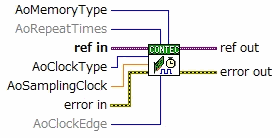

Select for continuous analog output

AoClockType |
[-1] Can be set |
Initial value: 0 (Internal clock) |
Specify the clock type (Internal clock/External clock)
0:
Internal clock
1: External clock
2: Synchronous Control Signal 1
3: Synchronous Control Signal 2
4: Synchronous Control Signal 3
AoSamplingClock |
[-1] Can be set |
Initial value: 1000 (uSec) |
Specify the speed of internal clock in uSec
*The range of configurable
clocks varies depending on the device
Please refer to [Device-specific
Setting List]
AoRepeatTimes |
[-1] Can be set |
Initial value: -1 (Not change) |
Specify the number of repeat times
Repeat action is the action from the sampling start to stop, which is performed for multiple times
0
: Repeat action is repeated infinitely
1 : Not perform repeat action
(Stop for sampling 1 time)
2 or more: Repeat action is performed
in the specified times
*When repeat analog output, set the memory
type to RING
So please specify AoMemoryType as 1 (RING memory)
*In the initial state and if terminal is not connected, which is same as specify this terminal to 1. Not perform repeat action
*Whether repeat action can be performed and
the upper limit of repeat times depend on devices
Please refer to [Device-specific
Setting List]
AoClockEdge |
[-1] Can be set |
Initial value: -1 (Not change) |
Specify the edge of external clock (Rising/Falling)
0:
Falling edge
1: Rising edge
*In the initial state and if terminal is not connected, which is same as specify this terminal to 0. Falling Edge is set
*The configurable external
clock edge varies depending on the device
Please refer to [Device-specific
Setting List]
AoMemoryType |
[-1] Can be set |
Initial value: 0 (FIFO) |
Specify the memory type(FIFO memory/RING memory
0:
FIFO
1: RING
Memory
for data storage of analog input/output devices can be used in
two formats, they are FIFO and RING. Please refer to the table below for features of each format and proper usage.
|